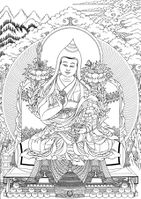Mi pham rgya mtsho
| Wylie | mi pham rgya mtsho |
|---|---|
| English Phonetics | Mipham Gyamtso |

- མི་ཕམ་འཇམ་དབྱངས་རྣམ་རྒྱལ་རྒྱ་མཚོ་
- འཇམ་དཔལ་དགྱེས་པའི་རྡོ་རྗེ་
- འཇུ་མི་ཕམ་
- mi pham 'jam dbyangs rnam rgyal rgya mtsho
- 'jam dpal dgyes pa'i rdo rje
- 'ju mi pham
| Birth: | 1846 |
|---|---|
| Death: | 1912 |
| Place of birth: | sde dge |
Tibetan calendar dates
| Day | |
|---|---|
| Month | |
| Gender | Male |
| Element | Fire |
| Animal | Horse |
| Rab Jyung | 14 |
- Religious Affiliation
- Nyingma
- Teachers
- 'jam dbyangs mkhyen brtse'i dbang po · 'jam mgon kong sprul · Dpal sprul 'jigs med chos kyi dbang po · Lung rtogs bstan pa'i nyi ma · Rdzogs chen bzhi pa mi 'gyur nam mkha'i rdo rje
- Students
- Las rab gling pa · 'jigs med bstan pa'i nyi ma · 'gyur med pad+ma rnam rgyal · A 'dzoms 'brug pa 'gro 'dul dpa' bo rdo rje · Lung rtogs bstan pa'i nyi ma · Dil mgo mkhyen brtse bkra shis dpal 'byor · Pad+ma dbang mchog rgyal po
Other Biographical info:
- BDRC Link
- https://www.tbrc.org/#!rid=P252
- Treasury of Lives Link
- http://treasuryoflives.org/biographies/view/Mipam-Gyatso/4228
- Wiki Pages
- Person description or short bio
Expand to see this person's philosophical positions on Buddha-nature.
| Is Buddha-nature considered definitive or provisional? | |
|---|---|
| Position: | Definitive |
| Notes: | "Mipam explains that the last wheel’s status as the definitive meaning does not refer to everything taught in the last wheel, but specifically concerns the teaching of Buddha-nature: ...'Although the meaning of the last wheel is praised in the sūtras and commentaries, [this does] not [refer to] everything in the last wheel, but is spoken in this way concerning the definitive meaning position of demonstrating the [Buddha-]nature.' Duckworth, D., Mipam on Buddha-Nature, pp. 4-5. |
| All beings have Buddha-nature | |
| Position: | |
| If "Qualified", explain: | |
| Notes: | |
| Which Wheel Turning | |
| Position: | Third Turning |
| Notes: | Buddha-nature is a third wheel teaching, but he holds both third and second to be of definitive meaning and integrates the two as noncontradictory in his presentation of buddha-nature as the unity of emptiness and appearance. Duckworth, D., Mipam on Buddha-Nature, pp. 4-5. |
| Yogācāra vs Madhyamaka | |
| Position: | |
| Notes: | |
| Zhentong vs Rangtong | |
| Position: | |
| Notes: | He aligns his view with Nagarjuna, but seems to assert rangtong in terms of the relative and zhentong in terms of the ultimate, as Duckworth quotes Mipam's Lion's Roar:
"First it is necessary to ascertain the lack of intrinsic nature of all phenomena in accordance with the scriptures of the protector Nāgārjuna; because if this is not known, one will not be able to ascertain the manner that relative [phenomena] are empty from their own side and the manner that the ultimate is empty of what is other. Therefore, one should first ascertain the freedom from constructs which is what is known reflexively." Duckworth, D., Mipam on Buddha-Nature, p. 71.
"In the tradition of self-emptiness, since there is only the ultimately nonexistent, an ultimately existing phenomenon is impossible. In the tradition of other-emptiness, what is ultimately nonexistent is the relative, and what is ultimately existent is the ultimate itself. My tradition is clear in the Rapsel Rejoinder, the tradition propounding self-emptiness." Duckworth, D., Mipam on Buddha-Nature, p. 74.
"When we consider Mipam’s depiction of emptiness in light of the categories of “self-emptiness” and “other-emptiness,” we can see that according to Khenpo Lodrö Drakpa’s definitions of a proponent of self-emptiness (claiming a non-implicative negation as the consummate ultimate) and other-emptiness (claiming wisdom as not empty of its own essence), Mipam is a proponent of neither self-emptiness nor other-emptiness. However, according to Lochen’s definitions of self-emptiness and otheremptiness, we see how Mipam can be said to be a proponent of both self-emptiness and other-emptiness!" Duckworth, D., Mipam on Buddha-Nature, p. 74. |
| Promotes how many vehicles? | |
| Position: | |
| Notes: | |
| Analytic vs Meditative Tradition | |
| Position: | |
| Notes: | |
| What is Buddha-nature? | |
| Position: | |
| Notes: | * "Mipam states that the basic element (Buddha-nature) is empty of adventitious defilements, yet not empty of consummate qualities. These consummate qualities are inseparable from the suchness of phenomena that is luminous clarity and self-existing wisdom." Duckworth, D., Mipam on Buddha-Nature, p. 18.
|
| Svātantrika (རང་རྒྱུད་) vs Prāsaṅgika (ཐལ་འགྱུར་པ་) | |
| Position: | |
| Notes: | |
| Causal nature of the vajrapāda | |
| Position: | |